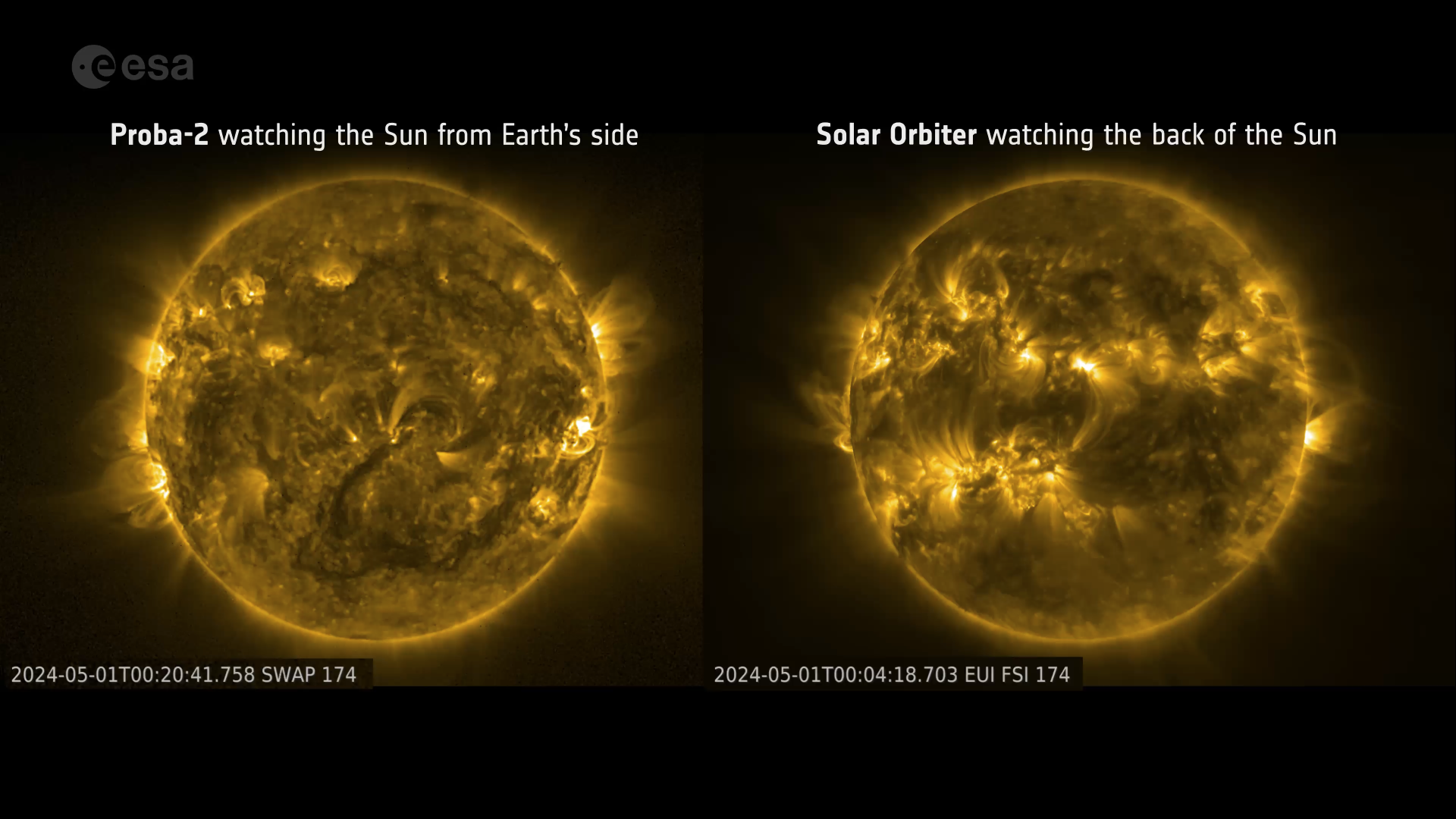Can't stop won't stop: Solar Orbiter shows the Sun raging on
The hyperactive sunspot region responsible for the beautiful auroras earlier in May was still alive and kicking when it rotated away from Earth’s view. Watching from the other side of the Sun, the ESA-led Solar Orbiter mission detected this same region producing the largest solar flare of this solar cycle. By observing the Sun from all sides, ESA missions reveal how active sunspot regions evolve and persist, which will help improve space weather forecasting.
In the weekend of 10–12 May 2024, the biggest solar storm to hit Earth in over 20 years swept over our planet. This produced an intense geomagnetic storm, creating beautiful auroras which lit up the sky at much lower latitudes than usual.
The culprit? An active sunspot region called AR3664. As it rotated away from Earth’s view around 14 May, it sent out the strongest flare yet (class X8.79), causing large radio blackouts on Earth. But the fact that we could not see it anymore from Earth did not mean that this monster had gone to sleep.
Watching the Sun’s far side on 20 May, Solar Orbiter’s X-ray instrument STIX observed a massive flare with an estimated class of X12. “This makes it the strongest flare yet of the current solar cycle, and in the top ten flares since 1996,” says ESA research fellow Laura Hayes.
X-class flares are the highest category of solar flares, and the higher the number following the X, the stronger the flare.

Watching the Sun from all sides
Most missions studying the Sun watch the side facing Earth, but Solar Orbiter is taking a different route through the Solar System. Because of the way the spacecraft moves with respect to Earth, Solar Orbiter is currently observing the Sun’s far side for more than four months. (Click here to see where Solar Orbiter is now.)
“Solar Orbiter’s position, in combination with other missions watching the Sun from Earth’s side, gives us a 360-degree view of the Sun for an extended period of time. This will only happen three more times in the future of Solar Orbiter, so we are in a unique situation to observe active regions on the far side that will then rotate into Earth’s view,” explains Daniel Müller, Solar Orbiter Project Scientist at ESA.


Access the video
Flare, energetic particles and coronal mass ejection
Immediately following the flare on 20 May, Solar Orbiter’s Energetic Particle Detector (EPD) detected a surge in ions moving at tens of thousands of kilometres per second, and electrons moving at near the speed of light.
Matching the time of this event, the computers on both BepiColombo and Mars Express (two of ESA’s planetary missions) saw a big jump in the number of memory errors, likely caused by solar energetic particles hitting physical memory cells inside the spacecraft. Mars Express Project Scientist Olivier Witasse notes: “These engineering data are meant to monitor spacecraft health, but this shows that they can also be used to detect space weather events, something not really foreseen!”
Soon after, Solar Orbiter’s Metis coronagraph saw the Sun blast out a so-called ‘coronal mass ejection’, and the MAG magnetometer witnessed its arrival at the spacecraft spacecraft about one day later. The huge bubble of plasma, made of charged particles moving at an average speed of around 1400 km/s, caused big swings in the magnetic field measured at the spacecraft. The Sun blasted out so much material that it was even seen from Earth’s side by the ESA/NASA SOHO mission.
These different datasets allow us to track the movement of particles and electromagnetic fields from this massive outburst throughout the Solar System. This, in turn, helps improve the accuracy of solar activity simulations.


Access the video
Improving space weather forecasts
The measurements from Solar Orbiter, Mars Express and BepiColombo made it clear that the AR3664 was still very much alive and kicking while out of Earth’s sight. This served as a warning for when the same region rotated back into Earth’s view.
Lo and behold, on 27 May the same region spewed out powerful radiation and bursts of particles. “If this flare and coronal mass ejection had been directed towards Earth, it would have caused another major geomagnetic storm for sure. But even like this, it resulted in a strong radio blackout over North America,” notes Daniel.

As recently as 11 June, Solar Orbiter witnessed yet another back-of-the-Sun X-class solar flare from AR3664. Understanding the behaviour of active regions like AR3664 throughout their entire lifetime will ultimately help predict how solar outbursts will affect Earth. ESA missions provide eyes and ears throughout the Solar System, using space science to benefit Earth.
Solar Orbiter’s back-of-the-Sun observations give a taste of what ESA’s space weather forecasting mission Vigil will do. Watching the left side of the Sun (as seen from Earth), the spacecraft will provide us with a constant feed of near real-time data on potentially hazardous solar activity before it rolls into view from Earth.
"Adding Vigil's data to our space weather services can give us forecasts up to 4–5 days earlier for certain space weather effects and provides more detail than ever before. Such early warnings give astronauts time to take shelter, and operators of satellites, power grids and telecommunication systems time to take protective measures," says Giuseppe Mandorlo, Vigil Project Manager at ESA.
Notes for editors
Solar Orbiter is a space mission of international collaboration between ESA and NASA, operated by ESA.














 Germany
Germany
 Austria
Austria
 Belgium
Belgium
 Denmark
Denmark
 Spain
Spain
 Estonia
Estonia
 Finland
Finland
 France
France
 Greece
Greece
 Hungary
Hungary
 Ireland
Ireland
 Italy
Italy
 Luxembourg
Luxembourg
 Norway
Norway
 The Netherlands
The Netherlands
 Poland
Poland
 Portugal
Portugal
 Czechia
Czechia
 Romania
Romania
 United Kingdom
United Kingdom
 Slovenia
Slovenia
 Sweden
Sweden
 Switzerland
Switzerland

























